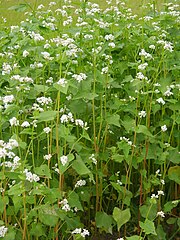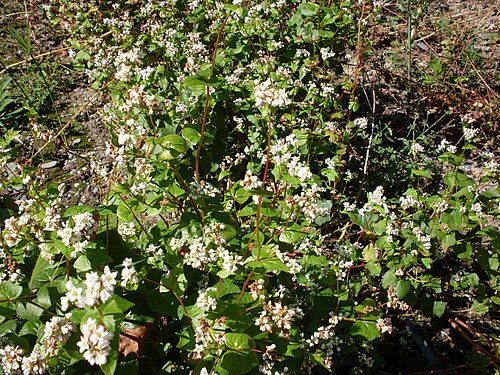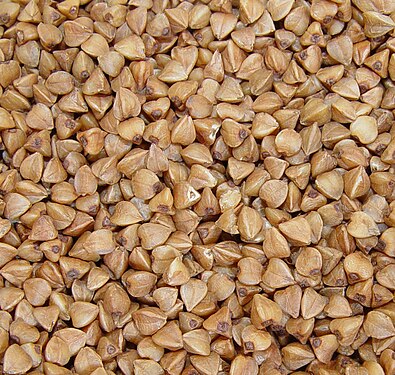|
|
| (One intermediate revision by one other user not shown) |
| Line 1: |
Line 1: |
| − | {{otheruses4|the food crop|the [[Our Gang]]/[[Little Rascals]] character|Billie "Buckwheat" Thomas}} | + | {{SPlantbox |
| − | {{Taxobox
| + | |familia=Polygonaceae |
| − | | color = lightgreen | + | |genus=Fagopyrum |
| − | | name = ''Common Buckwheat'' | + | |species=esculentum |
| − | | image = Illustration_Fagopyrum_esculentum0.jpg | + | |taxo_author=Moench |
| − | | image_width = 250px | + | |common_name=Buckwheat |
| − | | regnum = [[Plant]]ae | + | |habit=herbaceous |
| − | | divisio = [[Flowering plant|Magnoliophyta]]
| + | |features=edible |
| − | | classis = [[Dicotyledon|Magnoliopsida]] | + | |flowers=white |
| − | | ordo = [[Caryophyllales]] | + | |Temp Metric=°F |
| − | | familia = [[Polygonaceae]] | + | |jumpin=If this plant info box on watering; zones; height; etc. is mostly empty you can click on the edit tab and fill in the blanks! |
| − | | genus = ''[[Fagopyrum]]'' | + | |image=메밀.JPG |
| − | | species = '''''F. esculentum''''' | + | |image_width=180 |
| − | | binomial = ''Fagopyrum esculentum'' | |
| − | | binomial_authority = [[Conrad Moench|Moench]] | |
| | }} | | }} |
| | + | {{Otheruses4|the African/Eurasian buckwheat plant|other plants which are called similar common names|Wild buckwheat}} |
| | | | |
| − | '''Common buckwheat''' (''Fagopyrum esculentum'') is a [[plant]] in the [[genus]] ''[[Fagopyrum]]'' (sometimes merged into genus ''[[Polygonum]]'') in the family [[Polygonaceae]]. With its [[congener]]s [[Tartary Buckwheat|tartary buckwheat]] (''F. tartaricum'' Gaertn) and [[perennial buckwheat]] (''F. cymosum'' L.), it is often counted as a [[cereal]], though unlike most cereals the buckwheats are not [[Poaceae|grass]]es and are not related to true [[wheat]]. Buckwheat is most likely descended from [[wild buckwheat]], though it does not share its vine-like growth habit. | + | '''Buckwheat''' refers to plants in two genera of the [[dicot]] family [[Polygonaceae]]: the Eurasian genus ''[[Fagopyrum]]'', and the North American genus ''[[Eriogonum]]''. The crop plant, common buckwheat, is ''Fagopyrum esculentum''. [[Tartary Buckwheat|Tartary buckwheat]] (''F. tataricum'' Gaertn.) or "bitter buckwheat" is also used as a crop, but it is much less common. Despite the common name and the grain-like use of the crop, buckwheat is not a [[cereal]] or [[Poaceae|grass]]. It is called a [[pseudocereal]] to emphasize that it is not related to [[wheat]]. |
| | | | |
| − | The name "buckwheat" or "beech wheat" comes from its triangular seeds, which resemble the much larger seeds of the beech nut from the [[beech|beech tree]], and the fact that it is used like wheat. The etymology of the word is explained as partial translation of Middle Dutch boecweite : boek, beech; see [[Proto-Indo-European_language|PIE]] bhago- + weite, wheat. | + | The agricultural weed known as [[Wild Buckwheat]] (''Fallopia convolvulus'') is in the same family, but not closely related to the crop species. |
| | + | Within ''Fagopyrum'', the cultivated species are in the cymosum group, with ''F. cymosum'' L. (perennial buckwheat), ''F. giganteum'' and ''F. homotropicum''.<ref>{{cite journal|author=T. Sharma, S. Jana|year=2002|title=Species relationships in ''Fagopyrum'' revealed by PCR-based DNA fingerprinting|journal= Theoretical and Applied Genetics| |
| | + | doi=10.1007/s00122-002-0938-9|volume=105|pages=306–312|pmid=12582533|issue=2-3}}</ref> The wild ancestor of common buckwheat is ''F. esculentum'' ssp.''ancestrale''. ''F. homotropicum'' is interfertile with ''F. esculentum'' and the wild forms have a common distribution, in [[Yunnan]]. The wild ancestor of tartary buckwheat is ''F. tataricum'' ssp. ''potanini''.<ref>{{cite journal|author=Ohnishi, O., Matsuoka, Y.|year=1996|title=Search for the wild ancestor of buckwheat II. Taxonomy of ''Fagopyrum'' (Polygonaceae) species based on morphology, isozymes and cpDNA variability|journal= Genes and Genetic Systems|volume=71|pages=383–390 | doi = 10.1266/ggs.71.383}}</ref> |
| | | | |
| − | == Cultivation ==
| + | {{Inc| |
| − | | + | Buckwheat (Fagopyrum esculentum, Moench). Polygonàccse. A tender annual grain plant, flour being made of the large 3-cornered fr. It is much grown in the N. U. S., usually being sown about the first of July. It is also a favorite for bee forage. Buckwheat is native to Cent. Siberia and Manchuria, and is now widely cult., although it is a grain of secondary importance. The Tartarian buckwheat (F. tatáricum, Gaertn.) is occasionally seen. It has smaller and yellowish fls., and a smaller roughish, wavy- angled fr. This species is often confounded with forms of F. esculentum, from which it is really easily distinguished. Buckwheat is a good cleaning crop for weedy and hard lands. |
| − | Common buckwheat was domesticated and first cultivated in [[southeast Asia]], possibly around 6000 BC, and from there spread to Europe and to [[Central Asia]] and [[Tibet]]. Genetic evidence points to as the wild ancestor, with domestication most likely taking place in the western Sichuan and/or northwestern Yunnan regions of China.<ref>{{cite journal
| + | }} |
| − | | author=Kump, B. and Javornik, B.
| |
| − | | date=2002
| |
| − | | title=Genetic diversity and relationships among cultivated and wild accessions of tartary buckwheat (Fagopyrum tataricum Gaertn.) as revealed by RAPD markers
| |
| − | | journal=Genetic Resources and Crop Evolution
| |
| − | | volume=49
| |
| − | | pages=565-572
| |
| − | }}</ref> Buckwheat is documented in Europe in the Balkans by at least the [[Middle Neolithic]] (circa 4000 BC) and the oldest known remains in China so far date to circa 2600 BC. However, buckwheat pollen is present in Japan as early as 4000 BC suggesting either that ''(i)'' domestication of this plant occurred earlier than has been documented archaeologically; ''(ii)'' it spread more rapidly than previously acknowledged, or; ''(iii)'' there were two or more [[domestication]] events. It is the world's highest elevation domesticate, being cultivated in [[Yunnan]] on the edge of the [[Tibetan Plateau]] or on the Plateau itself.
| |
| − | | |
| − | [[Image:Fagopyrum esculentum1.jpg|thumb|left|200px|Common Buckwheat in flower]]
| |
| − | | |
| − | Buckwheat is a short season crop that does well on poor, somewhat acidic soils, but the soil must be well drained. Too much fertilizer, especially nitrogen, will greatly reduce yields. In hot climates, it can only be grown by sowing late in the season, so that it will bloom in cooler weather. The presence of [[pollinator]]s greatly increases the yield. The nectar from buckwheat flower makes a dark colored honey. Buckwheat is sometimes used as a [[green manure]], as a plant for [[erosion]] control, or as wildlife cover and feed.
| |
| − | | |
| − | Common buckwheat is by far the most important buckwheat species, economically, accounting for over 90% of the world's buckwheat production. A century ago, [[Russia]] was the world leader in buckwheat production.<ref>For details, see [[William Pokhlyobkin]]'s essay about buckwheat, available [http://vkus.narod.ru/raznoe/grechiha.htm online].</ref> Growing areas in the [[Russian Empire]] were estimated at 2,600,000 hectares, followed by those of [[France]] (355,000 hectares).<ref>J. R. N. Taylor, P. S. Belton. ''Pseudocereals and Less Common Cereals''. Springer, 2002. ISBN 3540429395. Page 125.</ref> In [[1970]] the [[Soviet Union]] grew an estimated 4.5 million acres (18,0
| |
| − | 00 km²) of buckwheat, but has since been overtaken by [[China]]. [[Japan]], [[Poland]], [[Canada]], [[Brazil]], [[South Africa]], and [[Australia]] also grow significant quantities of buckwheat.
| |
| − | | |
| − | Cultivation of buckwheat has declined sharply in the [[United States of America|United States]]. Over a million acres (4,000 km²) were harvested in [[1918]]. By [[1954]] that had declined to 150,000 acres (600 km²), and by [[1964]], the last year that production statistics were gathered, only 50,000 acres (200 km²) were grown.
| |
| | | | |
| − | == Use == | + | ==Cultivation== |
| − | [[image:Kasza gryczana 01.jpg|thumb|left|hulled buckwheat]]
| |
| − | The seed is an [[achene]], similar to a [[sunflower]] seed, with a hard outer shell and soft inner meat. The flour is noticeably darker than wheat flour, and is known (exaggeratedly) as "blé noir" ("black wheat") in French, along with the name ''sarrasin'' ("saracen").
| |
| − | [[Image:Hegisoba 001.jpg|thumb|right|200px|Soba noodles, made from buckwheat flour]]
| |
| − | In [[Japan]], the flour is made into [[noodle]]s (including [[soba]]), and as [[groats]]. Groats, that part of the grain left after the hulls are removed from the seeds, and [[farina]] made from groats are used for breakfast food, [[porridge]], and thickening materials in [[soup]]s, [[gravy|gravies]], and dressings. In [[Korea]], buckwheat [[starch]] is used to make a jelly called [[memilmuk]].
| |
| | | | |
| − | Buckwheat [[groats]] are also commonly used in eastern [[Europe]], often in form of "[[kasha]]" dish.<ref>In American usage, "kasha" is sometimes (inaccurately) used as the Russian/slavic name for buckwheat, rather than as an exact equivalent of "porridge". Buckwheat in Russian and other [[slavic languages]] is "grechka", "grechiha". It is possible the misnomer originates with Jewish immigrants, as "kashi" (distorted form, that would literally translate as "porridges") is sometimes sold in US supermarket as "Jewish national food".</ref> It is also used with [[wheat]], [[maize]] or [[rice]] in [[bread]] and [[pasta]] products. Buckwheat contains [[rutin]], a [[phytochemical|medicinal chemical]], used for vascular disorders; it is naturally devoid of [[gluten]], and can thus be eaten by people who react adversely to gluten.
| |
| | | | |
| − | Buckwheat [[pancakes]], sometimes raised with [[yeast]], are eaten in several countries. They are known as buckwheat [[blini]]s in [[Russia]], [[galette]]s in [[France]] (where they are especially associated with [[Brittany]]), [[ploye]]s in [[Acadia]] and ''boûketes'' (that is, named the same as the plant they are made of) in [[Wallonia]]. Similar pancakes were a common food in American pioneer days. They are light and foamy. The buckwheat flour gives them an earthy, mildly mushroom-like taste. In Ukraine, yeast rolls called ''hrechanyky'' are made from buckwheat.
| + | ===Propagation=== |
| | | | |
| − | Besides the seeds, from which buckwheat flour is produced, buckwheat is also a good [[honey]] plant, producing a dark, strong [[monofloral honey]]. Unlike the widely consumed seeds, buckwheat greens are toxic to humans. Eaten in sufficient quantities, the greens can induce an ensemble of symptoms, including an extreme sensitization of the skin to sunlight known as [[fagopyrism]].<ref>{{cite web|author=Arbor, G.|date=December 2004|url=http://www.townsendletter.com/Dec2004/buckwheat1204.htm|title=''Are Buckwheat Greens Toxic?''}} From the Townsend Letter for Doctors & Patients.</ref> Light pigmented livestock and fair skinned people are particularly susceptible. Enthusiasts of [[sprouting]], however, eat the very young buckwheat [[sprouts]] (four to five days of growth) for their subtle, nutty flavour and high nutritional value. In the past buckwheat cultivation was also used in orchards to increase the rate of pollination.
| |
| | | | |
| − | In the 1970s and 1980s, [[General Mills]] produced a sweetened, maple-flavored breakfast cereal made from buckwheat, which was marketed under the name ''Buc-Wheats.''
| + | ===Pests and diseases=== |
| | | | |
| − | === Upholstery filling ===
| |
| | | | |
| − | Buckwheat hulls are used as filling for a variety of [[upholstery|upholstered]] goods, including [[pillow]]s and [[zafu]]. The hulls are durable and do not conduct or reflect heat as much as synthetic
| + | ==Varieties== |
| − | fills. They are sometimes marketed as an alternative natural fill to feathers for those with allergies.
| |
| − | | |
| − | Medical studies to measure the health effects of buckwheat hull pillows have been performed.<ref>''Dermatophagoides Farinae, an Important Allergenic Substance in Buckwheat-Husk Pillows'', Yonsei Medical Journal 1987 December;28(4):274-281 [http://www.eymj.org/abstracts/viewArticle.asp?year=1987&month=12&page=274 HTML summary], [http://www.eymj.org/1987/pdf/274.pdf Full text PDF]</ref><ref>''Endotoxin and House Dust Mite Allergen Levels on Synthetic and Buckwheat Pillows'', Journal of Korean Medical Science, 2004; 19: 505-8
| |
| − | ISSN 1011-8934 [http://jkms.kams.or.kr/2004/pdf/08505.pdf PDF]</ref>
| |
| − | | |
| − | === Buckwheat and beer === | |
| − | | |
| − | In recent years, buckwheat has been used as a substitute for other grain in [[gluten free beer]]. Buckwheat is used in the same way as [[barley]] to produce a "[[malt]]" that can form the basis of a [[mash]] that will brew a [[beer]] without [[gliadin]] or [[hordein]] (together "[[gluten]]") and therefore can be suitable for [[coeliacs]] or others sensitive to certain [[glycoproteins]].<ref>{{cite web
| |
| − | | Carolyn Smagalski
| |
| − | | date = 2006
| |
| − | | url = http://www.glutenfreebeerfestival.com
| |
| − | | title = glutenfreebeerfestival.com
| |
| − | | publisher = Carolyn Smagalski, www.glutenfreebeerfestival.com
| |
| − | }}
| |
| − | </ref>
| |
| − | <!-- ==Trivia==
| |
| − | The buckwheat plant is celebrated in [[Preston County, West Virginia]] at their Buckwheat Festival where people can participate in swine, cow, and sheep judging contests, vegetable contests, and craft fairs. The area fire departments also play an important role in the series of parades that occur there. Each year there is a King and Lady Fireman elected. Also there are many rides and homemade, homegrown buckwheat cakes and sausage. -->
| |
| | | | |
| − | == Recipes ==
| |
| − | * [http://www.bbc.co.uk/food/recipes/database/buckwheatpancakes_80141.shtml Buckwheat pancakes]
| |
| − | * [http://www.bbc.co.uk/food/recipes/database/buckwheatnoodleswith_77288.shtml Buckwheat noodles with smoked salmon and dill]
| |
| | | | |
| − | == References == | + | ==Gallery== |
| − | {{Wikisource1911Enc|Buckwheat}}
| |
| − | * [http://www.hort.purdue.edu/newcrop/afcm/buckwheat.html Alternative Field Crops Manual]
| |
| − | * Damania, A.B. 1998. "Diversity of Major Cultivated Plants Domesticated in the Near East".[http://www.ipgri.cgiar.org/publications/HTMLPublications/47/ch07.htm]
| |
| − | * Mazza, G. 1992. Buckwheat (Fagopyrum esculentum), the crop and its importance, p. 534-539. In: R. MacRae (ed.). ''Encyclopedia of food science, food technology and nutrition''. Academic Press Ltd., London.
| |
| − | * Mazza, G. 1993. ''Storage, Processing, and Quality Aspects of Buckwheat Seed'', p. 251-255. In: J. Janick and J.E. Simon (eds.), New crops. Wiley, New York.
| |
| − | * Marshall, H.G. and Y. Pomeranz. 1982. ''Buckwheat description, breeding, production and utilization'', p. 157-212 In: Y. Pomeranz (ed.). Advances in cereal science and technology. Amer. Assoc. Cereal Chem., St. Paul, MN.
| |
| − | * McGregor, S.E. 1976. ''Insect Pollination Of Cultivated Crop Plants'', chap. 9 Crop Plants and Exotic Plants. U.S. Department of Agriculture. ''As found on the website of the Carl Hayden Bee Research Center of the [[United States Department of Agriculture|USDA]] Agricultural Research Service''.[http://gears.tucson.ars.ag.gov/book/chap9/buckwheat.html]
| |
| − | {{unimelb|Fagopyrum.html}}
| |
| | | | |
| − | == Footnotes== | + | <gallery perrow=5> |
| − | {{reflist}}
| + | File:Sarrasin 02.JPG |
| | + | File:Fagopyrum esculentum, Boekweit bloemen (1).jpg |
| | + | File:Fagopyrum esculentum fruits, Boekweit dopvruchten.jpg |
| | + | File:Fagopyrum гречка.jpg |
| | + | File:Illustration Fagopyrum esculentum0.jpg |
| | + | </gallery> |
| | | | |
| − | ==See also== | + | ==References== |
| − | *''[[Eriogonum]]'' - wild buckwheat | + | <references/> |
| − | {{Cereals}}
| + | *[[Standard Cyclopedia of Horticulture]], by L. H. Bailey, MacMillan Co., 1963 |
| | + | <!--- xxxxx *Flora: The Gardener's Bible, by Sean Hogan. Global Book Publishing, 2003. ISBN 0881925381 --> |
| | + | <!--- xxxxx *American Horticultural Society: A-Z Encyclopedia of Garden Plants, by Christopher Brickell, Judith D. Zuk. 1996. ISBN 0789419432 --> |
| | + | <!--- xxxxx *Sunset National Garden Book. Sunset Books, Inc., 1997. ISBN 0376038608 --> |
| | | | |
| − | == External links == | + | ==External links== |
| − | {{commons|Fagopyrum esculentum|Buckwheat}} | + | *{{wplink}} |
| − | * [http://www.whfoods.com/genpage.php?tname=foodspice&dbid=11 Nutritional information for buckwheat]
| |
| | | | |
| − | [[Category:Polygonaceae]]
| + | {{stub}} |
| − | [[Category:Cereals]]
| + | __NOTOC__ |
| − | [[Category:Underutilized crops]]
| |





